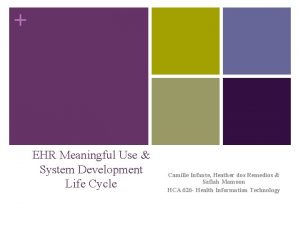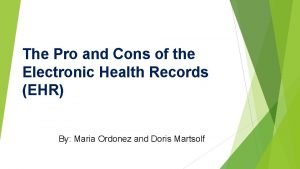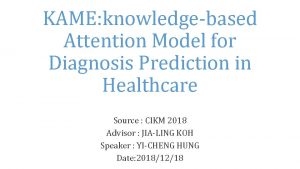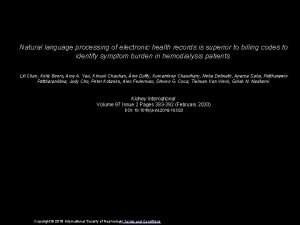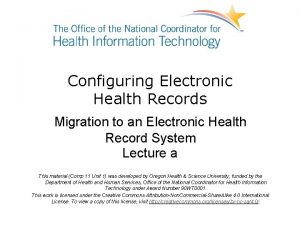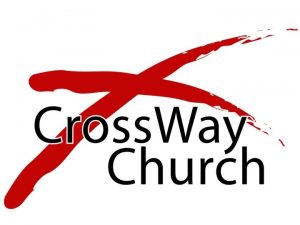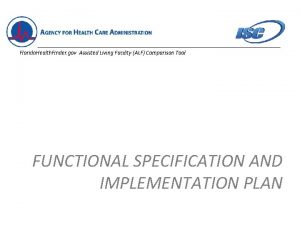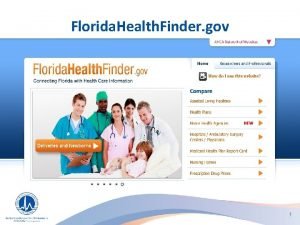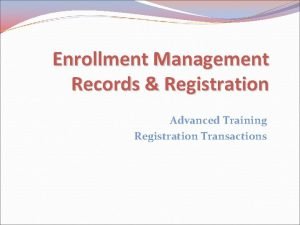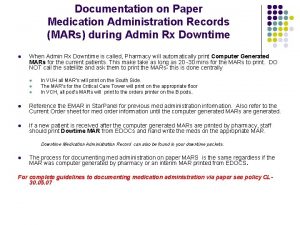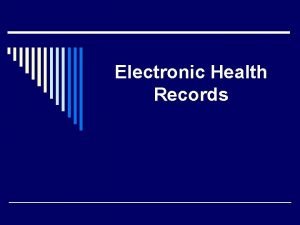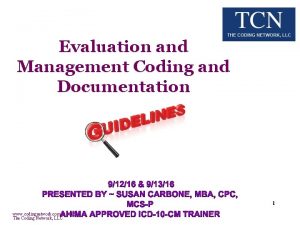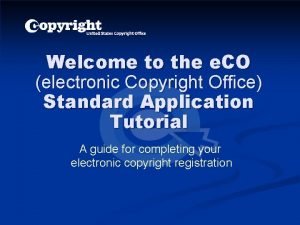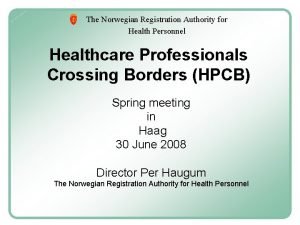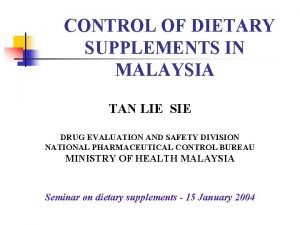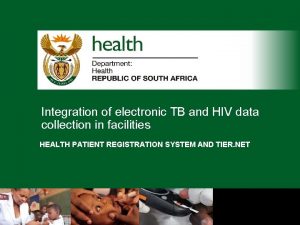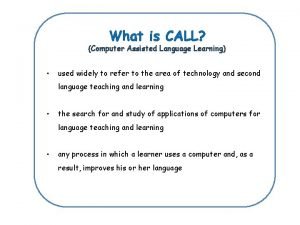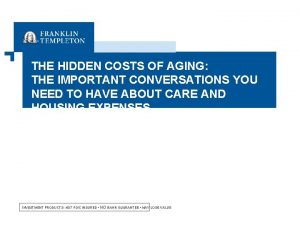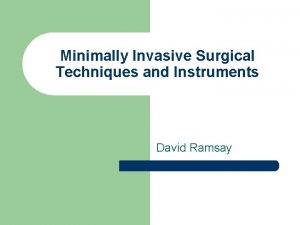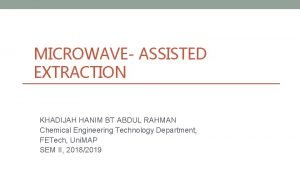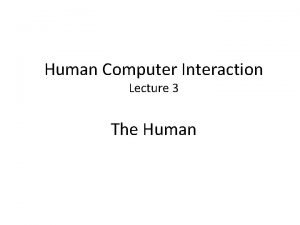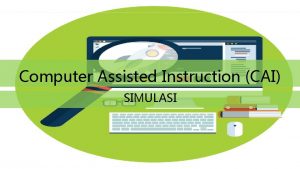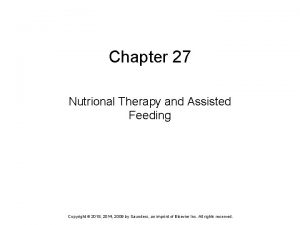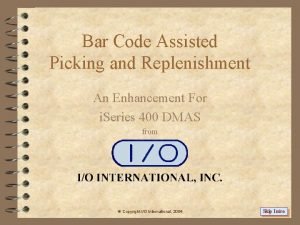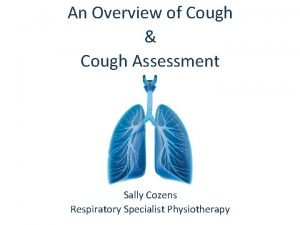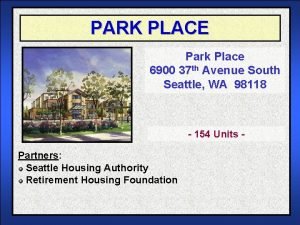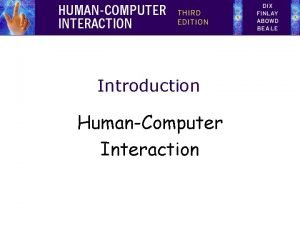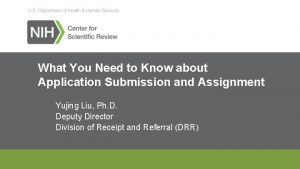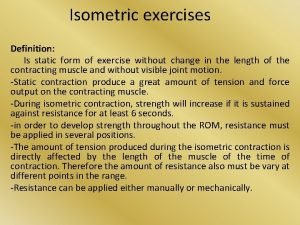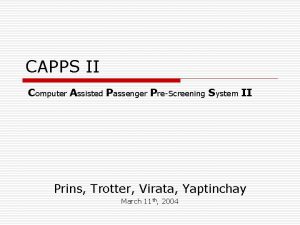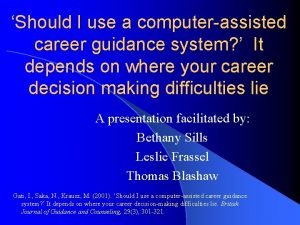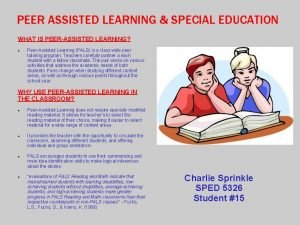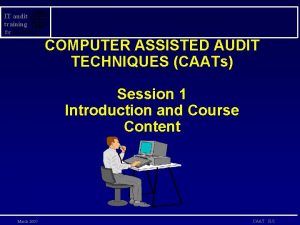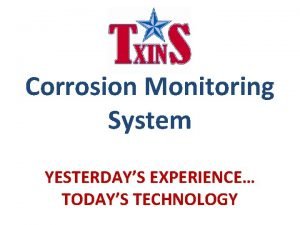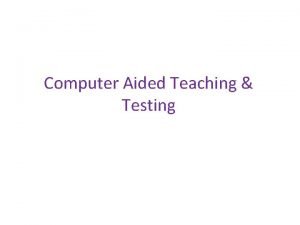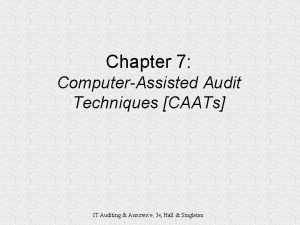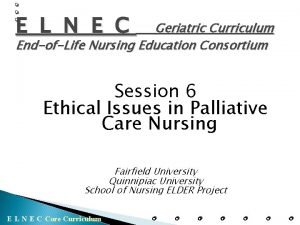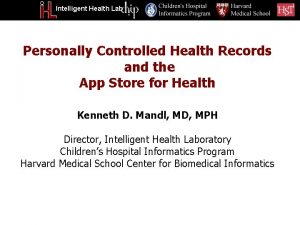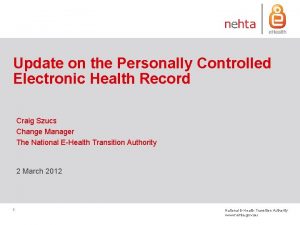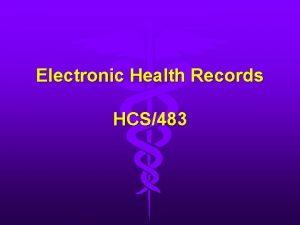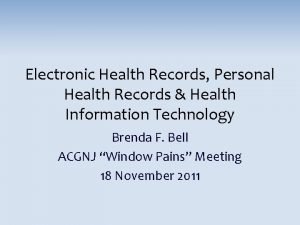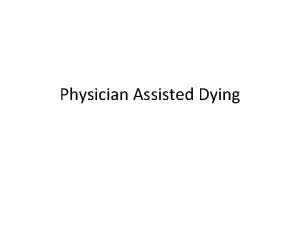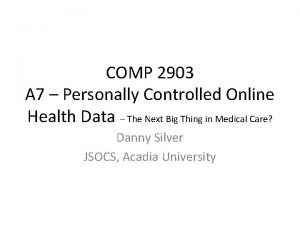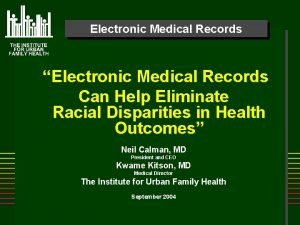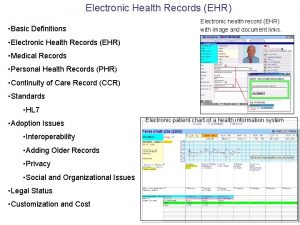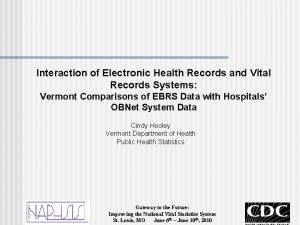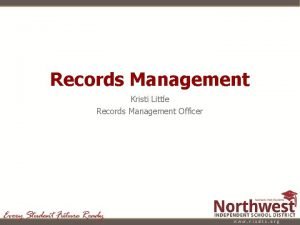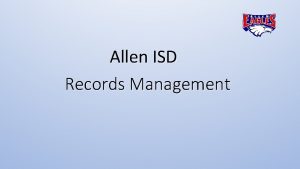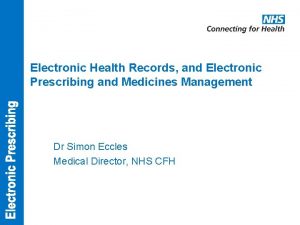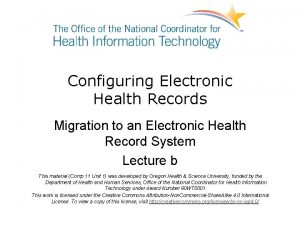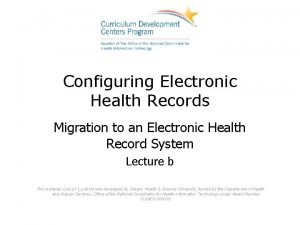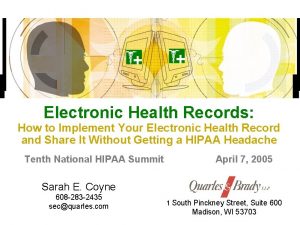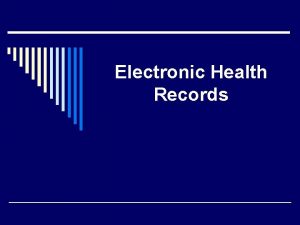Assisted Registration for Personally Controlled Electronic Health Records























































- Slides: 55

Assisted Registration for Personally Controlled Electronic Health Records (PCEHR) Training pack 1

The objective of today’s training Our goal is to help you become effective and informed in your role as an e. Health record assisted registration facilitator! By the end of the day, you should feel comfortable approaching healthcare consumers, explaining the e. Health system to them, and facilitating their registration 2

Personally controlled electronic health (e. Health) records: What you should know 3

Activity: Your questions (10 min) 1) Brainstorm questions you have about e. Health records, from what they are to how they affect you 2) Collate questions on a whiteboard or flip chart. We will revisit them at the end of the session to make sure they have all been answered 4

Contents ▪ What is an e. Health record? ▪ Why would I want one? ▪ Who can we register for an e. Health record? ▪ Privacy, security and handling your information ▪ How do I use my record? 5

What is a personally controlled electronic health (e. Health) record? The e. Health record system will allow the sharing of health information created by your healthcare providers, subject to any access controls you set It is an opt in system for both consumers and providers 6 SOURCE: Consumer Registration Booklet

How will the system grow? 7 Stage One Stage Two Stage Three The Australian Government is rolling out an e. Health record system and people seeking health care in Australia can now register for an e. Health record As the system develops over time, having an e. Health record will give your doctors and other healthcare professionals involved in your care access to a summary of your key health information, provided you have given initial consent As people and healthcare organisations register for the e. Health record system, your health care will become more connected which will result in better, faster and more efficient care for you SOURCE: e. Health. gov. au (FAQs)

Contents ▪ What is an e. Health record? ▪ Why would I want one? ▪ Who can we register for an e. Health record? ▪ Privacy, security and handling your information ▪ How do I use my record? 8

Activity: why would you want an e. Health record? Do you have an e. Health record? Have you viewed it? Why and when might an e. Health record be used? 9

Benefits for all consumers 10 • Best treatment – As the system grows, healthcare organisations such as a GP practice or local hospital will be able to quickly view a summary of your information, helping them to make the best possible decisions about your care. • More convenient – You will not have to remember every medication, test or healthrelated incident, or when a child was immunised. • Less stressful – Allows rapid access to information in an emergency. • Better health – You will be able to better manage your health. • Sharing the load – If you wish, you can share your health information with family members, carers, or other trusted people.

Some consumer groups are likely to particularly benefit • There are some cohorts who are likely to particularly benefit from having an e. Health record: – Parents and their babies – Older Australians – People living with chronic conditions – Aboriginal and Torres Strait Islander people – Mental health consumers • The features they may particularly benefit from include: – Better connected health records across different providers – Better connected health records across geographies – Better self-management – Ability to appoint a nominated carer 11

Contents ▪ What is an e. Health record? ▪ Why would I want one? ▪ Who can we register for an e. Health record? ▪ Privacy, security and handling your information ▪ How do I use my record? 12

Our assisted registration is one of five channels to register for an e. Health record Be assisted to register by an authorised employee assisting registration Online – visit www. ehealth. gov. au Over the phone – call 1800 723 471 and select option 1 In person – visit a Department of Human Services service centre offering Medicare services In writing – complete a registration form application form, available from a service centre offering Medicare services or from www. ehealth. gov. au, We should always try to register a consumer through our Assisted Registration channel before recommending other channels 13

Assisted Registration offers several advantages over other registration channels Quick Well-informed • Registration in just a few minutes, with a 100 point check e. g. photo ID and a Medicare Card • Face-to-face interaction and opportunity to raise any questions • Accurate information from trained personnel • Online and phone • registrations require more lengthy ID verification Other forms are much longer Online and written registrations involve no human interaction • Reliance on written documentation or “helpdesk” phone line to answer question Assisted registration Other registration channels • 14 Personalised

Who can you give assisted registration to? You can assist registration of anyone over the age of 14 that has a Medicare card You can assist registration of a parent’s children - The children must be under the age of 18 - The parent must have legal parental responsibility - The children must appear on the parent’s Medicare card You can assist anyone who has a DVA file number to register Registration of a child dependent ▪ ▪ ▪ 15 The parent will be able to access and control their child’s e. Health record through their own e. Health record Once the child turns 14, their Medicare information will no longer be visible to the parent, and the child will have the option to take control of their own e. Health record. Once the child turns 18, the parent will no longer be able to access their record (although the child may later choose to add their parent as a nominated representative)

Who can you not register? You cannot assist registration of any of the following categories of health consumers: A person without a Medicare card or DVA file number - These consumers can still register if they have an Individual Healthcare Identifier (IHI) - Direct these consumers to the Consumer Registration Booklet (below) A person below the age of 14 unless registering as a child dependent A child dependent who does not appear on the parent’s medicare card A person without capacity who seeks to register themself or whose carer seeks to register them An adult (over the age of 18) who is not present If you cannot provide assisted registration, the consumer can still register by another channel Direct these consumers to the Consumer Registration booklet (found online at www. ehealth. gov. au), where their steps for registering are clearly laid out 16 SOURCE: This information is from the Learning Centre module “How to register”

Contents ▪ What is an e. Health record? ▪ Why would I want one? ▪ Who can we register for an e. Health record? ▪ Privacy, security and handling your information ▪ How do I use my record? 17

The consumer is in control of what information is visible • • • 18 Most people are likely to allow any healthcare provider organisation involved in their care to access their e. Health record. This is therefore the default access control setting. You can, however, set access controls for your and/or your dependent's e. Health record by limiting access to: – The whole of the e. Health record – A specific document in the e. Health record If you realise that you do not want a specific document to be available in the e. Health record, you are still able to “effectively remove” it from view. It will not be available to either you or healthcare provider organisations, including in an emergency

Access to information without your consent 19 • There are some circumstances where the Personally Controlled Electronic Health Records Act 2012 authorises the collection, use and disclosure of health information without consent • The main circumstance where this occurs is likely to be when it is necessary to lessen or prevent serious threat to an individual’s life, health or safety (and your consent cannot be obtained) • Other circumstances are set out in the Personally Controlled Electronic Health Records Act 2012

Privacy and Security FAQs 20 • Who can see the information on my e. Health record? • How will my personal information be kept private? • What happens if someone accesses my record without my permission? • How can I view my e. Health record? • How do I get a log-in and password? • Who has access to my log-in details? • Will I be able to see who has accessed or updated my e. Health record? • Who has access to my e. Health record? • Will my e. Health record be as safe as my current medical records? • Where is the data on the e. Health record system kept? • Where can I find further information on privacy? See Privacy FAQ in the facilitator handbook or information online at ehealth. gov. au

Contents ▪ What is an e. Health record? ▪ Why would I want one? ▪ Who can we register for an e. Health record? ▪ Privacy, security and handling your information ▪ How do I use my record? 21

What will be on my e. Health record? • Medicare data will appear if you have chosen for it to do so, including: – Child immunisation – Organ donor register – Medicare claiming events – Subsidised medications dispensed • 22 As the system develops, more of your health care information can be added by the healthcare professionals involved in your care, including any treatment you may receive or medication you are prescribed

What can I do with my record? You can review information uploaded by others Over time you will be able to review your clinical information including your shared health summary, discharge summary, You can add information yourself event summaries and Medicare information 23

Further details can be found online at www. ehealth. gov. au FAQs for target consumer groups Consumer portal of the Learning Centre Consumer registration booklet and brochures Registering for your own e. Health record online Information about Assisted Registration including the “Essential Information” sheet 24

Activity: What is important to communicate to a consumer 1) Watch video Hear from a number of clinicians about how the e. Health record will benefit them and their consumers http: //www. youtube. com/watch? v=7 Ebwt. Lnaetk 2) Read through the PCEHR material provided [15 minutes] • Brochures (General, IVC) • Essential information on registration form 3) Work with a partner to write down what you think from the materials are the key messages for communicating with consumers [10 minutes] 4) Discuss and structure these key messages as a group [15 minutes] 25

Activity: Engaging with a consumer about the e. Health record (40 min) 1) Develop your own ‘elevator pitch’ about the e. Health record. Answer the questions: [10 minutes] - What is an e. Health record? - What are the benefits of an e. Health record? 2) In small groups share your elevator pitch with each other and give feedback (include something you think they could have improved on) [20 minutes] 3) Share lessons with the large group [10 minutes] - What was a particularly strong elevator pitch? - What worked well (both verbal and non verbal)? 26

How we assist a consumer to register for a Personally Controlled Electronic (e. Health) record: The theory 27

The Assisted Registration process ▪ Step 1: Identify the consumer ▪ Step 2: Fill in the registration form ▪ Step 3: Process the registration 28

Step 1: Identify the consumer ▪ You assert the identity of the consumer as a known customer, or using documentary evidence, according to the relevant policy ▪ For a child: You assert the identity of the parent (as above) AND you check that the child is on the same Medicare card as the parent who signed the form Identification check may be via the setting of care verifying the consumer as a known customer, or via you performing a 100 point identity check. 29

What the 100 point check is ▪ Different documents are assigned a certain number of ‘points’ toward proving your identity ▪ In almost all cases, the 100 points that you will be shown by consumers will be a combination of: a) Medicare card (35 points) b) Driver’s licence (70 points) c) Foreign driver’s licence (35 points) d) Credit card (35 points) ▪ 30 In your Handbook is a definitive list of what constitutes a 100 point ID check

Contents ▪ Step 1: Identify the consumer ▪ Step 2: Fill in the registration form ▪ Step 3: Process the registration 31

Step 2: Fill in the registration form ▪ The consumer should have their attention directed to the Essential Information section ▪ The consumer or facilitator completes and signs the one page application ▪ You check the form is complete and signed by the consumer Unless the details on the form are EXACTLY right, the registration will fail. It has not been uncommon to get 1 in 3 forms with errors in them. Checking the forms thoroughly is very important! 32

Registration form and potential pitfalls 33 ▪ 1. Family name – Entered first (even though it is second on the Medicare card) ▪ 1. First name – Entered to match their Medicare card i. e. often a full name like “Christopher” rather than “Chris” – Middle name/initial does not need to be entered ▪ 2. Date of birth – Common error is to put today’s date rather than year of birth, so this is important to check ▪ 3. Sex of applicant – Make sure to fill this in. It can be easy to skip to the Medicare number

Registration form and potential pitfalls 34 ▪ 4. Medicare number/DVA file number – For a Medicare card, enter the full number above the name (ignore the single-digit number to the left of the name) – Number of digits on the card should match number of boxes on the registration form ▪ 5. Identification as Aboriginal or Torres Strait Islander – entirely optional for the consumer to answer – Never answer this question on their behalf – always ask!

Registration form and potential pitfalls ▪ 35 6. Opting to receive an Identity Verification Code (IVC) – Enter contact details if consumer opts to receive an IVC – Explain that the IVC will allow them to access and control their details online – Enter either an email address or phone number as method of delivery – Check that the email address is legible! – If opting to receive by phone, ensure the number specified is a mobile phone, not a landline

Registration form and potential pitfalls ▪ 36 7. Opting to receive Medicare information – Explain that the consumer can opt to receive past and ongoing Medicare information currently held by the government – The consumer can freely choose all, none, or some of the categories – Most consumers opt into everything, and this can be encouraged if asked what to do – If the consumer is unsure, remind them that they always change what documents are able to viewed on their e. Health record – Note that the organ donor box is NOT consenting to becoming an organ donor. It just means that their existing donor decision is published on their e. Health Record

Registration form and potential pitfalls 37 ▪ 8. Sign and date the form – Ensure the form is signed and dated! – If you have filled out the form for the consumer, ask them to review their information and sign when they are confident the form is correct ▪ “Authorised staff use only” box – Put your initials – Note the ID used to reach 100 points (e. g. Medicare card and Driver’s Licence) – Include a contact phone number! This allows the consumer to be contacted if there any problems with their registration

The form for children is very similar 38 ▪ The top section still relates to the parent – Information here will be identical to the parent’s registration form ▪ The child’s details are entered according to how they appear on the Medicare card – Ensure the date of birth is correct (avoid the “today’s date” pitfall) – Ask the child’s gender rather than assuming based on their name – Ask if the children are of Aboriginal or Torres Strait Islander origin even if the parent did not identify as such ▪ Opting to receive an IVC is unnecessary if the parent is already receiving one – If so, leave this section blank – The parent will be able to use their personal IVC to access their child’s account

Handling child dependent registrations 39 ▪ Place child forms within their parent’s registration form ▪ Write the number of child forms on the front of the parent’s registration form ▪ If filling in multiple child forms, check if it is ok with the parent for you to only fill in the child section and to copy the parent’s details across later – If you do this, make sure that you double-check child information (name, DOB, gender) – Also ensure that the child form is signed and dated by the parent 1 child

Information to tell the consumer after registration 40 ▪ If the consumer has opted to receive an Identity Verification Code, tell them they can use it to set up online access to their e. Health record – The brochure “Accessing your personally controlled electronic health (e. Health) record online” contains a step-by-step guide of this process. – This brochure should be given to all consumers who register and opt to receive an IVC code – Tell consumers that they should receive their IVC within the next few days ▪ Tell the consumer that if there is a problem with the processing of their form, that they will be contacted

Completed forms must be guarded closely 41 ▪ Privacy of forms must be ensured at all times – Information on handed-in forms should not be shared with anyone ▪ Security of forms must be ensured at all times – Forms must be closely guarded – Ideally, file them away in a folder immediately – Keep this folder of completed forms on your person

Contents ▪ Step 1: Identify the consumer ▪ Step 2: Fill in the registration form ▪ Step 3: Process the registration 42

The Assisted Registration Tool mirrors the form: Details must be perfectly accurate! 43

Troubleshooting for submission errors There are various errors that you may be presented with. The two most common are: PCEHR_ERROR_5006 ▪ This will be because the information provided does not 100% match those in their Medicare record. This is why the information collected on the forms must be 100% accurate! ▪ You may check for obvious errors, e. g. if the consumer has stated their name as “Chris”, you may try “Christopher”. ▪ It may be possible to phone the consumer, and ask them to update their information, which you may need to collect in writing PCEHR_ERROR_5005 ▪ 44 No unique active IHI found No connection to HI server This error will often go away if you try again later

Once submitted, the system sends a response • The e. Health record system will send the outcome of the application: successful or unsuccessful – If successful, the consumer will receive an Identity Verification Code – If unsuccessful, the consumer needs to be notified and advised that they can apply through other channels 45

Which of these do you need to check? A. B. C. D. Check that they are an Australian citizen Use their Medicare card to check family name, given name and Medicare card number Ensure that there are no lipstick or other marks on the form Ensure within the Notes section that you have initialled, noted ID method, and that there is some way to contact the consumer E. Ensure all these steps are also carried out for children’s forms, especially the signature. Note that the parent does not have to fill in the IVC section on the child forms. Ensure each child’s name is sighted on the consumer’s Medicare card. Check all children are under 18. F. Store all documents securely in your satchel G. Check that their GP practice is registered H. Check that they are 18 or over I. Ensure that if the consumer has opted to receive an IVC, that the email or mobile phone number they have provided is clearly legible J. Check that they have internet access at home K. Use their other piece of ID to check photo, date of birth and name L. Ensure the form is signed and dated M. Fill in the form, being wary of common errors 46

Summary of assisted registration steps 1. Use the consumer’s Medicare Card to check family name, given name and Medicare card number 2. Use their other piece of ID to check photo, date of birth and name 3. Fill in the form, being wary of common errors 4. Ensure that if the consumer has opted to receive an IVC, the email or mobile phone number they have provided is clearly legible 5. Ensure the form is signed and dated 6. Ensure within the Notes section that you have initialled, noted ID method, and that there is some way to contact the consumer 7. Ensure all these steps are also carried out for children’s forms, especially the signature. Note that the parent does not have to fill in the IVC section on the child forms. Ensure each child’s name is sighted on the consumer’s Medicare card. Check all children are under 18 8. If the consumer has opted to receive an IVC, give them an “Accessing your personally controlled electronic health (e. Health) record online” brochure 9. Give the consumer a survey slip to fill out 10. Store all documents securely in your satchel 47

In action 48

In action 49

Be sensitive to the context in which you are facilitating 50 • Make sure you follow sign-in protocol and WH&S requirements (e. g. a safety induction) • If someone is called away for an appointment, let them go immediately and tell them that they can come back to you after • Only approach people in areas that have been agreed-upon with the site’s management team • Do not approach very sick or suffering people • Avoid clinical areas where treatment is occurring • Do not approach anyone talking on a Department of Health Services phone • Avoid giving details about total number of registrations, your pay, and other confidential information

Use your brochures to spread awareness You should attempt to give out one of these brochures to anyone who is not interested in Assisted Registration! • These brochures can also be left on your table for anyone to take • Steps through what an e. Health record is, and the different channels to register 51 Provides instructions for how to register by each of the four other channels

Brochures for specific consumer groups • • The brochures for specific consumer groups can be kept in your bag If someone identifies as being a part of one of these groups, feel free to give them a specific brochure Parents with newborns 52 Older Australians People with chronic conditions Aboriginal or Torres Strait Islander people Mental health consumers

Booklets with detailed information • • 53 These booklets should be kept in your bag for when a consumer specifically requires them Contains general e. Health information as well as detailed instructions on how to register individually • A copy of the essential information contained in the assisted registration form

Your facilitator handbook • • • 54 Your Handbook provides you with key information about your role as a facilitator It will help you with: – Important contacts – A checklist of collateral – Suggestions for setting up onsite – A list of ID for the 100 point ID check – A general FAQ and a privacy/security FAQ to help you answer tough questions from consumers (very helpful!) Not to be given to consumers – for your reference only

More lessons learned: Assisted registration on-the-ground Lessons learned ▪ Diligent checking of forms will reduce error rate ▪ Take initiative and approach people ▪ Wait for people to be seated before approaching them ▪ There is a ‘domino effect’ when registering people. Approach consumers who may be likely to register first. ▪ Find the information about the PCEHR that resonates most with consumers in your current healthcare setting ▪ Consumer’s can find answers to more complex questions through www. ehealth. gov. au or the helpline (1800 723 471) ▪ Be flexible based on the needs of the healthcare environment you are operating in 55
 System development life cycle of electronic health records
System development life cycle of electronic health records Electronic health records pros and cons
Electronic health records pros and cons Electronic health records
Electronic health records Natural language generation for electronic health records
Natural language generation for electronic health records +electronic +health +records +migration
+electronic +health +records +migration Does god know me personally
Does god know me personally How to know god personally four spiritual principles
How to know god personally four spiritual principles Personally identifiable information pii training 1 hour
Personally identifiable information pii training 1 hour Affective play space
Affective play space Facsimile finder
Facsimile finder Floridahealthfinder.gov/facility locator
Floridahealthfinder.gov/facility locator Utep records and registration
Utep records and registration Electronic mars records
Electronic mars records Paper vs electronic medical records
Paper vs electronic medical records Uncitral model law on electronic signatures
Uncitral model law on electronic signatures Benefits of public health
Benefits of public health Electronic medical records
Electronic medical records Electronic copyright registration
Electronic copyright registration Scrip exchange
Scrip exchange Electronic news gathering and electronic field production
Electronic news gathering and electronic field production Norwegian directorate of health registration
Norwegian directorate of health registration Health supplement +registration malaysia
Health supplement +registration malaysia Health patient registration system (hprs)
Health patient registration system (hprs) What is computer assisted language learning
What is computer assisted language learning Hidden costs of assisted living
Hidden costs of assisted living Robot assisted surgery
Robot assisted surgery Microwave assisted extraction
Microwave assisted extraction Laser assisted bonding
Laser assisted bonding Derive logically necessary conclusion from given premises.
Derive logically necessary conclusion from given premises. Advantages of computer assisted language learning
Advantages of computer assisted language learning Contoh cai
Contoh cai Chapter 27 nutritional therapy and assisted feeding
Chapter 27 nutritional therapy and assisted feeding Assisted picking
Assisted picking Cofflator
Cofflator Assisted service restaurant
Assisted service restaurant What part
What part Park place assisted living seattle
Park place assisted living seattle Information is lost gradually but very slowly
Information is lost gradually but very slowly Nih assisted referral tool
Nih assisted referral tool Hardware assisted virtualization in cloud computing
Hardware assisted virtualization in cloud computing Eno pointe assisted living
Eno pointe assisted living Isometric exercise def
Isometric exercise def Computer assisted passenger prescreening system
Computer assisted passenger prescreening system Small party assisted rescue
Small party assisted rescue Apnea
Apnea Computer assisted guidance systems
Computer assisted guidance systems Peer assisted
Peer assisted Biometric assisted proctoring
Biometric assisted proctoring Computer assisted audit techniques slideshare
Computer assisted audit techniques slideshare Georgia senior living association
Georgia senior living association Hydrogen assisted cracking
Hydrogen assisted cracking What is computer aided teaching
What is computer aided teaching Protea senior living
Protea senior living Test data method auditing
Test data method auditing Field assisted sintering technique
Field assisted sintering technique Ethical issues in nursing education
Ethical issues in nursing education
